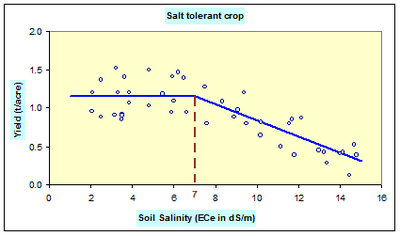

Crop response to soil salinity in ECe. Salt tolerance in ECe is 7 dS/m

Irrigation
editIrrigation inevitably leads to the salinization of soils and waters. In the United States yield reductions due to salinity occur on an estimated 30% of all irrigated land. World wide, crop production is limited by the effects of salinity on about 50% of the irrigated land area. In many countries irrigated agriculture has caused environmental disturbances such as waterlogging, salinization, and depletion and pollution of water supplies. Concern is mounting about the sustainability of irrigated agriculture. [1]
Salinity
editSaline and alkali soil conditions reduce the value and productivity of considerable areas of land in the United States. The problem is an old one, and there is much information on this subject in the technical literature. Many crop failures result from growing crops that have low salt tolerance. Alfalfa, barley, sugar beets, and cotton are tolerant crops that can often be grown where salinity is a problem.[2]
Salt Farm
editA farm on the island of Texel, The Netherlands, is testing the salt tolerance of crops. [3]. An example of results is shown in the figure below. The figure is based on a figure in the report. The soil salinity is expressed in electric conductivity (ECe). The Maas-Hoffman model is used. Envelope lines (yellow) and error ranges (brown) have been added.
Yield curve
edit| Curved model for crop response to soil salinity. See: Van Genuchten-Gupta model |
References
edit- ^ United States Department of Agriculture, Agricultural Research Service, U.S. Salinity Laboratory, Riverside, California, U.S.A. Frequently Asked Questions About Salinity. On line [1]
- ^ L. A. Richards, Editor, 1954. Diagnosis and Improvement of Saline and Alkali Soils. USDA Agriculture Handbook No. 60 prepared by United States Salinity Laboratory Staff, Agricultural Research Service. On line: [2]
- ^ Salt Farm Texel, 2017. Crop salt tolerance brochure. On line: [3]